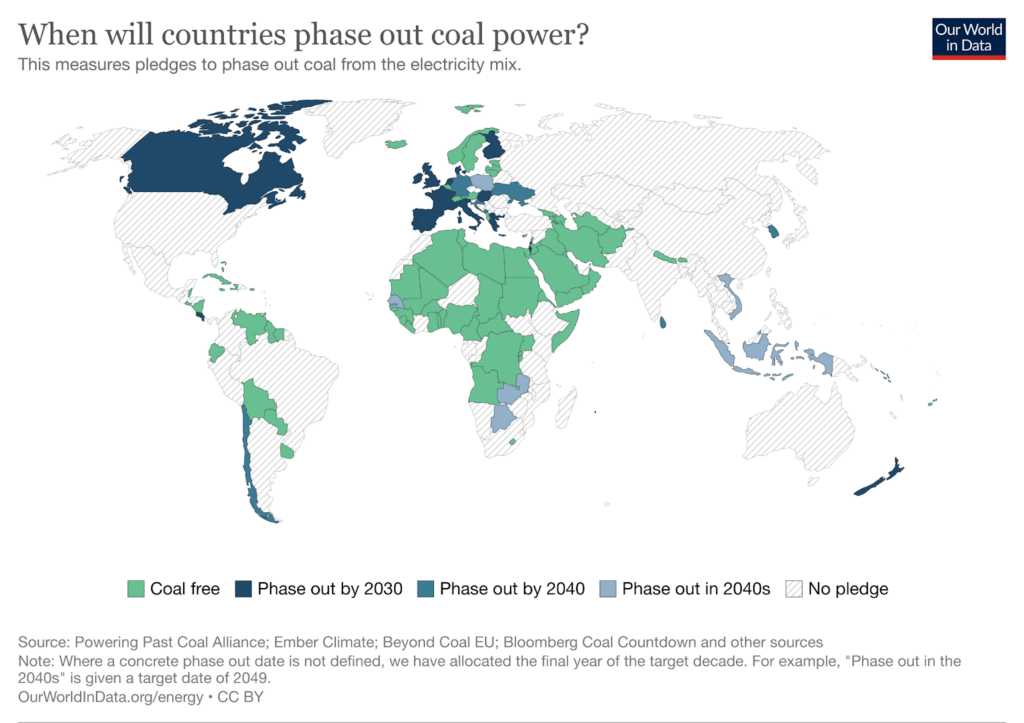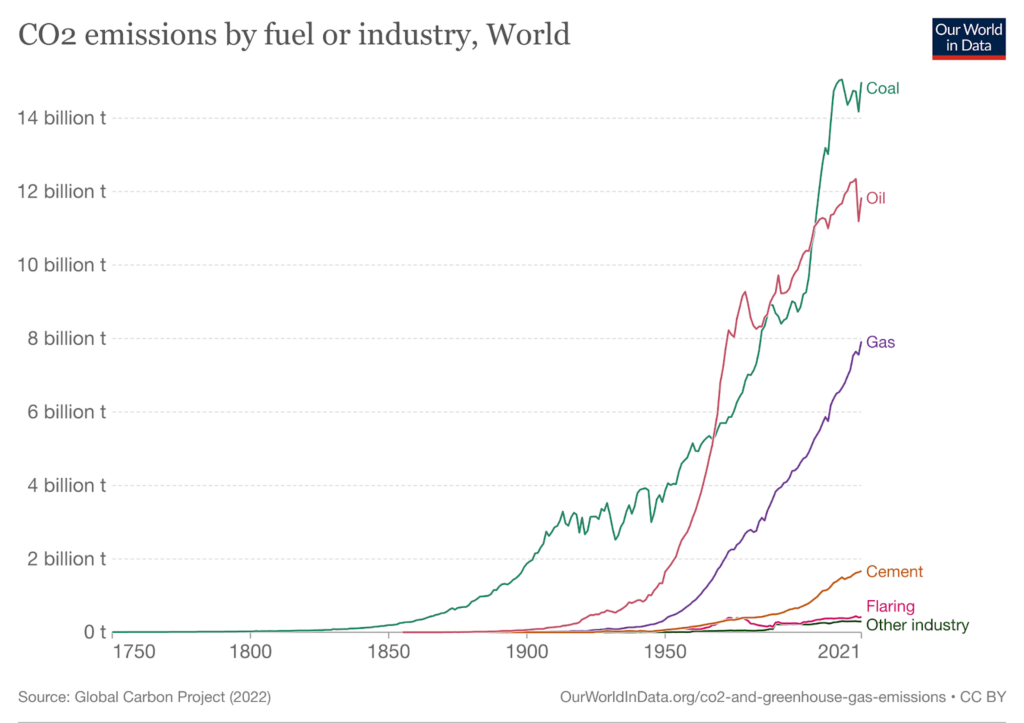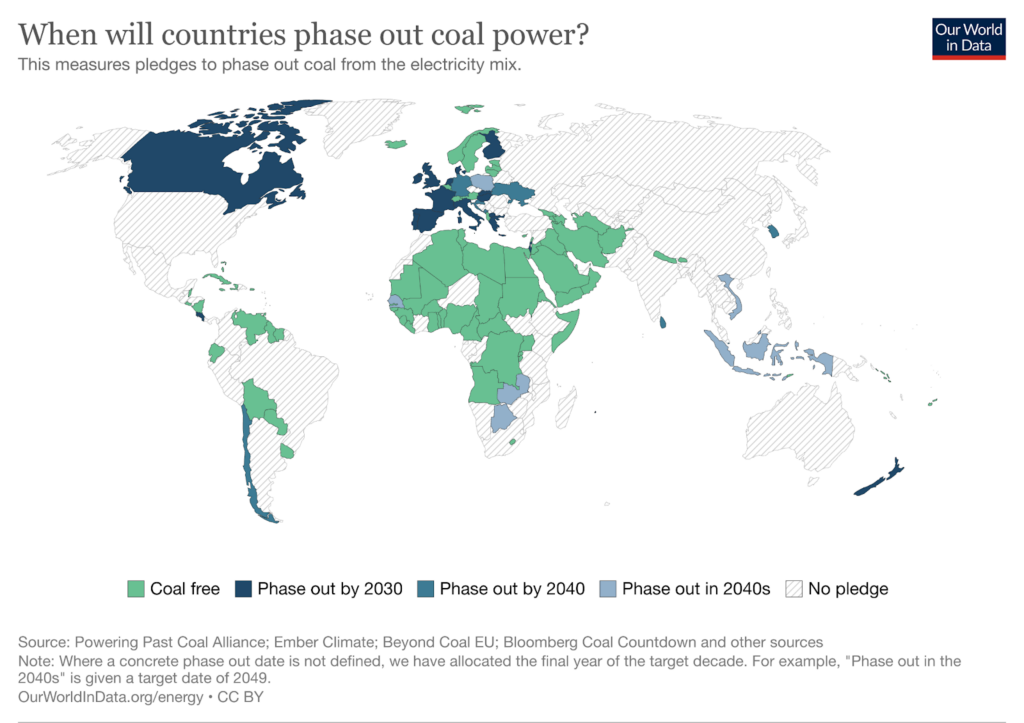The History of Coal Energy: The Big Picture
Affiliate Disclosure
Hey fellow impactful ninja ?
You may have noticed that Impactful Ninja is all about providing helpful information to make a positive impact on the world and society. And that we love to link back to where we found all the information for each of our posts.
Most of these links are informational-based for you to check out their primary sources with one click.
But some of these links are so-called "affiliate links" to products that we recommend.
Why do we add these product links?
First and foremost, because we believe that they add value to you. For example, when we wrote a post about the environmental impact of long showers, we came across an EPA recommendation to use WaterSense showerheads. So we linked to where you can find them. Or, for many of our posts, we also link to our favorite books on that topic so that you can get a much more holistic overview than one single blog post could provide.
And when there is an affiliate program for these products, we sign up for it. For example, as Amazon Associates, we earn from qualifying purchases.
What do these affiliate links mean for you?
First, and most importantly, we still only recommend products that we believe add value for you.
When you buy something through one of our affiliate links, we may earn a small commission - but at no additional costs to you.
And when you buy something through a link that is not an affiliate link, we won’t receive any commission but we’ll still be happy to have helped you.
What do these affiliate links mean for us?
When we find products that we believe add value to you and the seller has an affiliate program, we sign up for it.
When you buy something through one of our affiliate links, we may earn a small commission (at no extra costs to you).
And at this point in time, all money is reinvested in sharing the most helpful content with you. This includes all operating costs for running this site and the content creation itself.
What does this mean for me personally?
You may have noticed by the way Impactful Ninja is operated that money is not the driving factor behind it. It is a passion project of mine and I love to share helpful information with you to make a positive impact on the world and society. However, it's a project in that I invest a lot of time and also quite some money.
Eventually, my dream is to one day turn this passion project into my full-time job and provide even more helpful information. But that's still a long time to go.
Stay impactful,
Coal today provides over 35% of the world’s electricity and 70% of the world’s steel. Although it expanded rapidly up to 2000, coal has faced criticism in the 21st century due to its negative environmental effects. So, we had to ask: What is the history of coal energy?
Coal energy began millions of years ago with the formation of coal. The invention of the steam engine in 1712 and the age of the Industrial Revolution created a huge demand for coal. After the first coal-fired power plant opened in 1882, coal steadily became our primary source of electricity.
Keep reading to learn how coal energy came to be, who and what pioneered its development, how effective it has been thus far, and what the future of coal energy could entail.
Here’s the History of Coal Energy in a Nutshell
Coal is one of the three main fossil fuels (e.g., coal, oil, and natural gas).
“Coal: a combustible black or dark brown rock consisting mainly of carbonized plant matter, found mainly in underground deposits and widely used as fuel.”
Cambridge Dictionary
Coal energy is produced via the combustion of pressurized plant and animal remains. The heat created upon combustion creates steam which spins a turbine and spins a generator to produce electricity.
Coal energy has gone through three distinct development phases in its development:
- Early market formation and innovation: The early history of coal dates back over 350 million years to the Carboniferous time period, when coal was formed from decaying organic materials. Coal has been used for cooking, heating, and pottery since the age of the caveman.
- Consolidation and strengthening: The invention of the steam engine in 1712, followed by the Industrial Revolution in the 1750s created a huge demand for coal. The opening of the first coal-fired power plant kickstarted the coal energy movement.
- Mainstreaming: Coal replaced wood as the primary source of fuel in the 1600s and became a part of the mainstream electricity industry in the late 1800s. The establishment of the International Energy Agency (IEA) and International Renewable Energy Agency (IRENA) have facilitated the transition away from coal and towards cleaner forms of energy as the climate crisis continues to worsen.
| Coal Energy Milestones | Historical Event |
| Initial start | The early history of coal energy dates back over 350 million years to the Carboniferous period, when coal was formed from decaying organic materials. Coal has been used for cooking, heating, and pottery since the age of the caveman. |
| Milestones in coal energy development | 1712: Thomas Newcomen invented the first steam engine, which allowed miners to dig deeper and access more coal. 1760-1830: The Industrial Revolution in Britain created a huge demand for coal. 1769: James Watt invented the first coal-powered steam engine. His design had separate condensers, which made it more efficient than the Newcomen steam engine. 1882: The world’s first coal-fired power plant, the Holborn Viaduct plant, opened in London. 1990-2010: Roughly 1.7 billion people gained access to electricity due to coal. |
| Current status | Currently, coal is one of the most important and cheapest primary fossil fuels used for domestic energy generation and overseas transport. In 2022, we consumed over 44,000 terawatt-hours (TWh) of coal and generated almost 36% of the planet’s electricity from coal alone. |
| Future outlook | The future of coal energy will be heavily influenced by ambitious government targets, policy support, and increasing competitiveness and decreasing costs of renewable energy companies.In the short term, coal will remain one of our primary energy sources. In the long term, coal demand is forecasted to decrease in response to increasing renewable energy capacity. |
| Key policy developments | 1974 – The International Energy Agency (IEA) 1992 – World Coal Association (WCA) 1995 – The International Hydropower Association (IHA) 2001 – World Nuclear Association (WNA) 2005 – Global Wind Energy Council (GWEC) 2009 – The International Renewable Energy Agency (IRENA) 2013 – Ocean Energy Europe (OEE) 2015 – International Solar Alliance (ISA) |
Understanding coal energy’s history can provide insight into how it has evolved into the primary energy source it is today.
When and How Did Coal Energy Get Started
The early history of coal dates back over 350 million years ago to the Carboniferous time period.
“Carboniferous: containing or producing carbon.”
Cambridge Dictionary
The Carboniferous period was dominated by vast swamp forests, which provided the organic material and ideal conditions for coal to form. As plant and animal remains gradually built up on the earth’s surface and the ocean floor, they mixed with sand, silt, and calcium carbonate. Under immense heat and pressure, some of those remains were then converted into coal.
Researchers date the use of coal all the way back to the Stone Age, which occurred over 2.6 million years ago. Cavemen used coal for primitive heating and cooking purposes during this time.
900 BC: Archeological evidence of coal used to burn funeral pyres was recovered in Wales.
300 AD: Coal cinders were found near the outcrop of coal seams, underground formations of coal, in the UK.
1100s: The Hopi Indians of the US used coal for heating, cooking, and in ceremonial chambers.
1200s: Coal was widely used in China for heat and as a trading commodity. The first lumps of coal washed ashore in London. Later that century, monks began mining outcroppings of coal in northern England.
1300s: The Hopi Indians of the US used coal industrially in pottery making.
How Has Coal Energy Developed Over Time
Fossil fuel consumption began with the Industrial Revolution, and consumption has increased exponentially over the past 70 years. Today, coal is one of the most important and cheapest primary fossil fuels used for domestic energy generation and overseas transport.
What Are Milestones in Coal Energy Development
We have been mining and using coal since the age of the caveman, but it wasn’t until the 1700s when the invention of the steam engine kickstarted the coal energy movement.
1600s: Coal gained traction and gradually began replacing wood as the primary source of fuel.
1712: Thomas Newcomen invented the first steam engine, which was used to pump water out of mines. This allowed miners to dig deeper into coal seams and mine greater amounts of coal.
1760-1830: The Industrial Revolution in Britain created a huge demand for coal to power new machines (i.e. steamships and steam-powered railroads).
1769: James Watt invented the first coal-powered steam engine. His design had separate condensers, which made it more efficient than the Newcomen steam engine. His model would serve as the basis for future improvements.
1882: The world’s first coal-fired power plant, the Holborn Viaduct plant, opened in London. It burned enough coal to power over 1,000 lamps. A second power plant opened later that year in New York City (US).
1990-2010: Roughly 1.7 billion people gained access to electricity due to coal.
2022: We generated almost 36% of the planet’s electricity generation from coal alone.
How Has the Coal Energy Market Developed Recently
Following rapid growth in the 1800s and 1900s, global coal consumption has plateaued in the 2000s.
2019: Global electricity production from coal was 9,617 terawatt-hours (TWh). Global coal demand declined by 1.7% and coal power generation declined by 3.1% (315 TWh) compared to 2018. It was also the first year where renewables and nuclear energy produced more electricity than coal.
2020: Global electricity production from coal was 9,214 TWh. The COVID-19 pandemic played a role in reduced coal demand and coal power generation.
2021: Global electricity production from coal was 10,081 TWh. Following the COVID-19 pandemic, coal consumption rebounded by over 6%.
2022: Global electricity production from coal was 10,190 TWh. High natural gas prices resulting from the Russia-Ukraine war and extreme weather events brought on by human-induced climate change contributed to global coal-fired generation reaching an all-time high.
What Is the Present Status of Coal Energy
Coal consumption again reached all-time highs in 2022 after a 4.8% decrease in 2020 due to the COVID-19 pandemic and a sharp 6.3% rebound in 2021.
In 2022, we consumed over 44,000 TWh worth of coal, which was second only to oil.

We also generated almost 36% of the planet’s electricity from coal alone, higher than any other fuel type.

China is the world’s largest coal producer and consumer. They produced roughly 25,000 TWh worth of coal in 2022, which is 5 times more than India, the world’s second-largest coal producer and consumer.

There are over 1,100 operational coal-fired power plants in China that account for over 50% of global coal production and nearly 33% of global coal consumption. In 2022, China added an additional 11 GW of installed capacity to its power grid, increasing coal power generation by roughly 2% compared to 2021.

In terms of carbon emissions, the world collectively emits 14.98 billion tons of carbon dioxide (CO2) from coal, higher than that from all other industries.

How Will the Future of Coal Energy Look Like
Ambitious government targets, policy support, and increasing competitiveness and decreasing costs of renewable energy companies will heavily influence the future of coal energy.
How Coal Energy Will Likely Develop in the Future
In the short term, coal will remain one of our primary energy sources. Experts predict global coal demand and supply will remain high in 2023 and 2024. Decreasing demand in the US and the European Union will largely be balanced out by increasing demand in China, India, and Indonesia.
In the long term, coal demand is forecasted to decrease in response to increasing renewable energy capacity in advanced economies. We will also run out of coal because it is a finite resource. If we continue to use it at our current rate, we can expect to run out of coal in approximately 100 years.
Many countries have already or are currently in the process of phasing out coal energy from their electricity mix. For example, Canada, Costa Rica, and Finland have pledged to phase out coal by 2030 whereas Chile and Germany are aiming for 2040.

More and more countries have committed to phasing out coal because:
- Coal has a high carbon footprint: On a life-cycle basis, coal emits 820 grams of carbon dioxide (CO2) equivalent per kWh of electricity produced, which is second only to oil.
- Coal greatly exacerbates global warming: This phenomenon occurs when CO2 and other air pollutants absorb sunlight and solar radiation in the atmosphere, trapping the heat and acting as an insulator for the planet. Coal combustion produces over 14 billion tons of CO2 emissions every year which accelerates the insulating effect. In addition, coal combustion produces methane (CH4) emissions, which are 25 times more potent than CO2 at trapping heat in our atmosphere.
- Coal degrades air quality: Burning coal releases numerous pollutants including mercury, lead, sulfur dioxide, nitrogen oxides, particulates, and other heavy metals. These cause numerous health problems including asthma, breathing difficulties, brain damage, heart problems, cancer, neurological disorders, and premature death. The US EPA does set pollutant limits, but many plants do not have the necessary pollution control installed.
- Coal can cause water pollution: A byproduct of coal energy production is the leftover coal ash residue that contaminates ponds, lakes, landfills, and other sites which could eventually lead to the contamination of waterways and drinking water supplies. Another concern is acid rock drainage from coal mines, the destruction of mountaintop streams and valleys by mountaintop removal mining, and the reliance of coal plants on local water supplies.
- Coal produces toxic waste products: Coal contains large amounts of toxic heavy metals and chemicals that, if not contained properly in reservoirs, can leach into surface and groundwater supplies and cause problems such as cancer, birth defects, reproductive disorders, neurological damage, learning disabilities, and kidney disease.
What Policies Are Put in Place to Reduce Coal Energy Usage
The most well-known piece of legally binding, international climate mitigation legislation is The Paris Agreement, the goal of which is to limit global warming to below 2 degrees Celsius (C), preferably to 1.5C, compared to pre-industrial levels.
The Paris Agreement specifically notes a transition away from fossil fuels (e.g., coal) and towards renewable energies (e.g., solar, wind, hydropower) as being a critical part of meeting these goals.
Check out the highlights of the 2015 COP21 directly from the UN Climate Change channel:
In addition, The International Energy Agency’s (IEA) Net Zero Emissions by 2050 Scenario is one framework for the global energy sector to achieve net zero CO2 emissions by 2050 and universal energy access by 2030.
Currently, coal energy has been labeled as ‘off track’ in the Net Zero Emissions by 2050 Scenario.
CO2 emissions from coal grew 2% in 2022. This is not on track with the 55% reductions in unabated coal‐fired generation and reductions in global energy generation from coal to 12% by 2030 as laid out by the IEA.

There are many global and country-specific policies and organizations aimed at reducing fossil fuel usage, specifically coal, and meeting the 2050 net zero scenario, including:
- 1974 – The International Energy Agency (IEA): The IEA was founded in response to the major oil disruptions in 1974. It promotes international energy cooperation and is made up of 31 member countries.
- 1992 – World Coal Association (WCA): The WCA was founded to facilitate industrial and governmental cooperation to advance clean coal technologies. Because coal is still vital to many economies, the WCA seeks to upgrade current coal plants with technologies to reduce CO2 emissions.
- 1995 – The International Hydropower Association (IHA): The IHA is a nonprofit membership association that serves as a global voice for hydropower energy. They operate in over 120 countries and manage over 1/3rd of global installed hydropower capacity.
- 2001 – World Nuclear Association (WNA): The WNA was established as the leading international organization to represent the global nuclear energy industry.
- 2005 – Global Wind Energy Council (GWEC): The GWEC was founded as an international trade association for the wind energy industry. Their members represent 99% of the global installed wind power capacity.
- 2009 – The International Renewable Energy Agency (IRENA): IRENA was founded as a global intergovernmental agency focused on scaling renewable energy. It is comprised of 167 member countries as well as the European Union.
- 2013 – Ocean Energy Europe (OEE): They are the largest global network of marine energy professionals, with over 120 member organizations. They aim to advance tidal and wave energy technologies.
- 2015 – International Solar Alliance (ISA): The ISA is a treaty-based organization established to create cooperation among solar energy-resource-rich countries and the rest of the world. There are currently 94 member countries.
If you are interested in learning more about country-specific energy policies, you can visit the IEA’s policies database and filter by specific energy type.
What Are Currently the Different Types of Coal Energy
The process of coal mining has also undergone distinct phases in its development:
- Mine entry: The transition from surface mining to underground (shaft) mining and the development of mechanized hoisting mechanisms.
- Ventilation: The transition from natural ventilation tunnels to surface stacks, furnaces, and ventilating fans.
- Extraction: The transition from manual to mechanized extraction via the development of continuous and longwall mining practices.
- Haulage: The transition from manual labor to electric power, the institution of mechanized loading, and the invention of conveyor belts simplified the hauling process.
- Preparation: The transition from handpicking larger pieces of coal out of other minerals to having machinery separate coal from other rocks on the basis of density differences.
The type of fuel we consume today has shifted from solely coal to coal and oil, and lastly to coal, oil, and natural gas. The 21st century has seen a call to transition away from fossil fuels towards more renewable energy sources. Coal production and consumption has therefore begun to decrease in some countries.
Not all coal is the same. In fact, there are 4 main types, or ranks, of coal depending on the type and amount of carbon the coal contains and the amount of heat energy the coal can produce:
- Anthracite: The highest rank of coal. A hard, brittle, and black lustrous coal that is often referred to as hard coal because it contains the highest concentration of coal (86-97%) out of all coal ranks.
- Bituminous: A middle rank of coal. It has a 45-65% carbon content and is typically used for electricity generation and steel making because it has a high heating (Btu) value.
- Subbituminous: A middle rank of coal. It has a 35-45% carbon content and is typically used in electricity generation because it has a low-to-moderate heating value.
- Lignite: The lowest grade of coal, also referred to as brown coal. It contains the least concentration of carbon (25-35%), has a high moisture concentration, has a low heating value, and is typically used in electricity generation.
There are also 4 main methods of mining used today:
- Surface: This involves extracting materials from the Earth by digging them out with heavy machinery. Surface mining is the most common form of mining.
- Underground: This involves drilling holes into the Earth and using explosives to blast tunnels so that drill rigs can extract the materials. Tunnels are filled in with concrete afterward to prevent damaging the surrounding environment any further.
- Placer: This involves mining stream beds for mineral deposits. This method has less of an environmental impact and requires less effort for extraction.
- In situ: This involves injecting chemicals, either above or below ground, to dissolve metals so they can flow to the surface. It is commonly used to recover gold, silver, zinc, lead, uranium, and some other metals.
The largest mine in the world is the North Antelope Rochelle Surface Mine located in Wyoming, US. The mine possesses 1.4 billion tons of coal reserves and produced over 60 million tons of coal in 2022.
Burning coal without adding to atmospheric CO2 levels and releasing toxic materials is a major challenge. Although there are ways to reduce the environmental impact, they are often expensive and difficult to implement. Various methods to do so include:
- Desulfurization: Equipment known as flue gas desulfurization (FGD) scrubbers are installed in smokestacks to remove sulfur dioxide (SO2) emissions before they enter the atmosphere. The coal industry has also made strides in the development of technology that can remove impurities from coal, making coal more energy-efficient.
- Carbon capture: Separating CO2 from coal emissions and recovering it in a concentrated stream for later injection underground (sequestration). This method is difficult, expensive, would increase the fuel needs of a power plant, and would likely double the price of electricity.
- Re-use and recycling: Reducing the environmental effects of coal production and use by reclaiming land used for coal mining and repurposing it as airports, landfills, and golf courses. Waste emissions captured by scrubbers can be used in the production of products such as cement and synthetic gypsum for wallboard.
Final Thoughts
The early history of coal dates back over 350 million years to the Carboniferous time period when coal was formed from decaying organic materials subjected to intense heat and pressure. Coal has been used for cooking, heating, and pottery since the age of the caveman, but it wasn’t until the invention of the steam engine in 1712, followed by the Industrial Revolution in the 1750s, that the coal industry took off.
Coal became a part of the mainstream electricity industry in the late 1800s. Currently, we generate over 33% of the world’s electricity from coal alone. Following rapid growth in the 1800s and 1900s, coal consumption has plateaued in the 2000s as more light has been shed on the global climate crisis.
Experts predict coal will remain our primary source of electricity in the short term, although it will eventually be overtaken by renewable energies such as solar, wind, and hydropower. Long-term, experts insist we must slash coal usage dramatically in order to slow global warming.
Stay impactful,

Sources
- World Coal Association: Coal Facts
- US Energy Information Administration: Coal Explained
- University of California Museum of Paleontology Museum: The Carboniferous Period
- History: Stone Age – Definition, Tools & Periods
- Impactful Ninja: Fossil Fuel Energy Explained – All You Need to Know
- Natural Resources Defense Council: Fossil Fuels – The Dirty Facts
- Britannica: Coal – Plant Matter, Carbonization, Sedimentary Rocks
- The US Department of Energy: Fossil Energy Study Guide – Coal
- Dyball Associates: A Brief History of Energy – Coal
- Reviews in History: The Smoke of London
- National Geographic: Coal
- Our World in Data: CO2 emissions by fuel
- Age of Revolution – Newcomen Beam Engine
- Britannica – Industrial Revolution | Definition, History, Dates, Summary, & Facts
- World History Encyclopedia – Watt Steam Engine
- National Grid ESO: How does coal generate electricity?
- Equinor – The British Energy Revolution
- Drax – The turbulent history of coal
- Society for Mining, Metallurgy & Exploration – Coal’s Importance to the World
- CNBC: Goal consumption hit an all-time high in 2022, IEA says
- Statista: Global coal power generation 2022
- International Energy Agency: Coal – Global Energy Review 2019 – Analysis
- Forbes: Global Coal Consumption Surged In 2021
- International Energy Agency: Demand – Coal Market Update – July 2023 – Analysis
- International Energy Agency: Supply – Coal Market Update – July 2023 – Analysis
- Coal 2021
- Our World in Data: Fossil Fuels
- Statista: Global coal production share by country 2022
- Our World in Data: Fossil fuel consumption by fuel type, World
- Our World in Data: Share of electricity production from coal
- Our World in Data: Coal production, 2022
- Our World in Data: Coal consumption, 2022
- Our World in Data – CO2 emissions by fuel
- MET Group: When will fossil fuels run out?
- Our World in Data: When will countries phase out coal power?
- World Nuclear Association: Carbon Dioxide Emissions From Electricity
- Union of Concerned Scientists: The Hidden Costs of Fossil Fuels
- US Environmental Protection Agency: Importance of Methane
- Union of Concerned Scientists: Coal Power Impacts
- US Energy Information Administration: Coal and the environment
- United Nations Framework Convention on Climate Change: The Paris Agreement
- The International Energy Agency: Homepage
- The International Energy Agency: Net Zero Emissions by 2050 Scenario
- The International Energy Agency: Coal
- The International Energy Agency: Net Zero Emissions
- International Energy Agency: Annual change in generation and CO2 emissions from unabated coal-fired power plants in the Net Zero Scenario, 2015-2030
- The International Hydropower Association: Homepage
- World Coal Association: Homepage
- World Nuclear Association: Homepage
- Global Wind Energy Council: Homepage
- The International Renewable Energy Agency: Homepage
- Ocean Energy Europe: Homepage
- International Solar Alliance: Homepage
- Impactful Ninja: The History of Hydropower Energy – The Big Picture
- Impactful Ninja: The History of Nuclear Power – The Big Picture
- Impactful Ninja: The History of Wind Energy – The Big Picture
- Impactful Ninja: The History of Tidal Energy – The Big Picture
- Impactful Ninja: The History of Wave Energy – The Big Picture
- Impactful Ninja: The History of Solar Energy – The Big Picture
- International Energy Agency: Policy database – Data & Statistics
- International Energy Agency: Policy database – Data & Statistics
- US Geological Survey: What are the types of coal?
- American Geosciences Institute: What are the different types of coal?
- American Mine Services: Different Types of Mining
- Peabody: North Antelope Rochelle Mine
- Impactful Ninja: Coal Energy Explained: All You Need to Know





